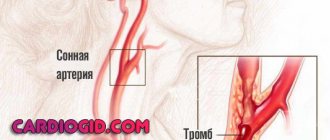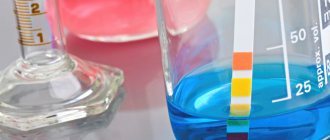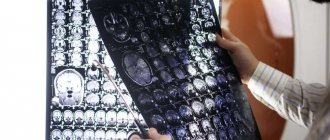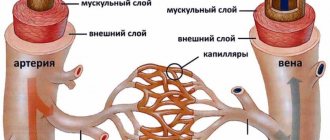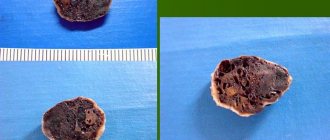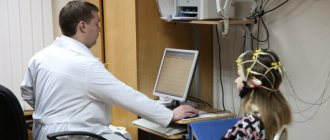Author:
Mironova Irina Sergeevna 5/5 (1 rating)
Honey. portal:
Causes Symptoms Diagnostics Treatment Our advantages Treatment price
Retinal angiopathy is not an independent disease. This is a manifestation of those diseases that affect the blood vessels of the human body, including the network of blood vessels in the retina. Angiopathy manifests itself as a pathological change in blood vessels, which is caused by a violation of nervous regulation. Now more attention is being paid to this disorder, because it often leads to tragic consequences, including loss of vision. Retinal vascular angiopathy is detected in both children and adults, although it most often occurs in people over 30 years of age.
It is customary to classify this pathology according to the diseases that caused its development. Angiopathy happens:
- Diabetic. Damage to the vessels of the retina is caused by an advanced form of diabetes mellitus, in which all blood vessels in the body are affected, which leads to a significant deterioration in blood flow and blockage of blood vessels. Due to this condition, vision loss occurs;
- Hypertensive. Which can develop against the background of existing hypertension. Hypertension provokes branching of veins, their expansion, frequent pinpoint hemorrhages in the eye, and clouding of the eyeball. Successful treatment of hypertension guarantees spontaneous disappearance of aniopathy, without additional therapy;
- Hypotonic. This angiopathy is characterized by a decrease in the tone of small vessels and is accompanied by overflow of blood vessels, which also causes blood clots. One of the signs of hypotonic retinal angiopathy is the pulsation of the eye vessels felt by the patient;
- Traumatic. Such retinal angiopathy can develop with damage to the cervical spine, traumatic brain injury, or sudden significant compression of the chest. Angiopathy is caused by compression of the blood vessels of the cervical spine or increased intracranial pressure;
- Youthful. This is the most unfavorable type of angiopathy, the causes of which have not yet been fully investigated. Its most common manifestations are: inflammation of blood vessels, hemorrhages that can occur in the retina or vitreous body. Often there is an overgrowth of connective tissue on the surface of the retina, leading to cataracts, glaucoma, retinal detachment and blindness.
Diagnostics
The disease is diagnosed by an ophthalmologist based on symptoms and after a general examination of the patient. In order to clarify the diagnosis, studies are prescribed, including ultrasound scanning of blood vessels, which provides information on the speed of blood circulation, as well as the condition of the walls of blood vessels, or X-ray examination, which is carried out using a contrast agent, to inspect the patency of blood vessels. Sometimes magnetic resonance imaging may be needed, which allows you to determine the structure of soft tissues and their condition.
Causes of pathology
Often, signs of angiodystonia in patients appear as an independent pathology, as a disorder accompanying another disease. Vascular tone worsens in this situation: problems with the endocrine system, poor functioning of the gastrointestinal tract, causing metabolic disorders, varicose veins, central nervous system diseases, increased ICP, allergies, amyloidosis.
The disease manifests itself against the background of such diseases: physical inactivity, high index of central nervous system lability, impressionability, prolonged smoking, alcohol abuse.
Treatment
Understanding that retinal angiopathy is a consequence of a systemic disease, to treat it, it is necessary to eliminate the underlying pathology. With hypertensive angiopathy, the leading role in treatment belongs to normalizing blood pressure and reducing blood cholesterol levels. To treat diabetic angiopathy, in addition to previously prescribed glucose-lowering drugs, a mandatory special diet is added, which excludes foods high in carbohydrates from the diet. Moderate physical activity is also useful, as it can support the functioning of the heart and blood vessels.
To alleviate the condition of the blood vessels of the eyes, drugs that normalize blood circulation are indicated: pentilin, trental, vasonite, solcoseryl, arbiflex, emoxipine, etc. The listed drugs improve the bendability of red blood cells, which ensures activation of blood flow in the capillaries. Patients with fragile blood vessels are recommended to take calcium dobesilate. This drug thins the blood, improves its circulation in the vessels, and normalizes the permeability of the vascular walls.
Treatment of retinal angiopathy involves the use of physiotherapeutic methods: magnetic therapy, acupuncture and laser exposure. These procedures can improve the general condition of the patient.
Retinal angiopathy is a reversible side condition that many are not inclined to take seriously. And yet, in an advanced form without adequate treatment of the underlying disease, it leads to severe deterioration of vision or even its complete loss.
What is cerebral angiodystonia?
It is generally accepted that problems with blood vessels often bother older people.
However, this does not always happen. In some cases, the disease develops in childhood or young adulthood. An example of such a pathology is cerebral angiodystonia of cerebral vessels. Typical manifestations of this disease are: sleep and memory disturbances, slow mental activity, dizziness. Focal symptoms are less common. Angiodystonia of cerebral vessels is most often a sign of some neurological disease. However, in some cases the cause cannot be determined. In this case, a diagnosis is made: dystonia of the hypo- or hypertonic type. In addition to headaches, a decrease or increase in blood pressure and fainting are often observed. This pathology means a change in the tone of cerebral vessels. Such disturbances may affect a specific area of the brain or the blood supply as a whole. The clinical picture observed during the disease depends on this.
Our advantages
"Moscow Eye Clinic" offers comprehensive diagnostics and effective treatment of eye diseases. The use of modern equipment and the experience of specialists working in the clinic eliminate diagnostic errors.
Based on the results of the examination, each visitor will be given recommendations on choosing the most effective methods of treating the eye pathologies identified in them.
The high level of theoretical training and practical experience of our doctors guarantees the achievement of good treatment.
Angiopathy during pregnancy
Since in pregnant women the blood volume increases several times with the growth of the fetus, the blood vessels increase accordingly. Changes in the circulatory system cause angiopathy in pregnant women. Additionally, it is provoked by a hormonal factor, which is observed in the first trimester. In the second and third trimester, a decrease in peripheral vascular resistance occurs due to the functioning of the uteroplacental circulatory system. Another reason that can provoke angiopathy in pregnant women is gestosis. Identifying such a pathology in pregnant women carries risks, since standard treatment methods cannot always be used in this situation. In some cases where there is a risk of retinal detachment, the doctor may recommend a cesarean section.
Our licenses
Prevention of angiopathy
Treatment is not just about taking medications. It is very important to maintain a proper diet and change your lifestyle. The diet should be low in salt and animal fats, high in potassium and magnesium. The patient should also increase physical activity. If intense exercise is contraindicated for a person, it is necessary to select a set of gymnastic procedures adapted to his activity and capabilities. Sometimes walking or cycling is enough. It is important that the exercises are performed systematically.
In order for the blood vessels, including the blood vessels of the eyes, to be in normal condition, it is important to follow simple rules:
- Do not abuse alcohol, get rid of nicotine addiction.
- Prevent the development of hypertension, diabetes and other provocateurs of angiopathy.
- Periodically undergo courses of treatment if the disease is chronic.
- Carry out a preventive examination every year, even if there are no obvious vision problems.
- When angiopathy is detected in pregnant women, in order to avoid retinal detachment, a cesarean section is recommended.
The eyes are an important organ, without which a person would not be able to receive so much information from the outside world. Retinal angiopathy can deprive a person of a normal life and make him disabled. Therefore, any visual impairment, even minor, must be accurately diagnosed and corrected in an ophthalmology clinic. And serious diseases such as diabetes and hypertension must be constantly monitored.
Manifestations
At the initial stage, it is very difficult to detect the presence of angiodystonia of retinal vessels. The disease does not bother you and does not even manifest itself in any way. Only after some time the following symptoms begin to appear:
- decreased visual acuity;
- pulsation inside the eye;
- blurred vision, flashes, clouding;
- reduction of the boundaries of the visible field;
- yellow spots and broken vessels that become visible on the conjunctiva of the eye;
- impairment in the form of farsightedness.
Both eyes or only one may be affected. If the disease develops into a severe form, then even loss of vision is possible.
Forecast
If you have such a diagnosis, you must strictly follow the doctor’s recommendations, take prescribed medications and monitor your lifestyle. The doctor must regularly monitor the patient's condition, even if there are no symptoms. Angiodystonia rarely leads to disability, complete or partial. Such cases are extremely rare in medical practice. In this case, complex treatment should be prescribed, and the symptoms are severe. When prescribing complex therapy, the condition and reaction of the body should be monitored. If there are negative changes, treatment should be changed in accordance with the existing changes.
How to recognize
We have collected all the signs of angiodystonia that can be used to determine its presence. The situation is complicated by the presence of underlying diseases, against which the problem of interest to us arises. And yet, the presence of angiodystonia can be detected by the following symptoms:
- pain in different areas of the body, it can be the cervical spine, back, limbs;
- allergic manifestations that have not previously bothered or appeared;
- frequent occurrence of loose stools.
One of the types of the problem is cerebral angiodystonia, which is characterized by disruption of the blood vessels of the brain. In this case, the symptoms of angiodystonia will look like this:
- pain in the temples and back of the head, which can be aching, throbbing or dull;
- numbness in the arms and legs;
- manifestation of swelling;
- increased changes in blood pressure;
- pain in the area of the heart muscle;
- arrhythmia, dizziness, lightheadedness, darkening of the eyes;
- impaired memory, vision, sleep deterioration;
- general weakness in the body, drowsiness and increased fatigue;
- dysfunction of the endocrine system;
- uncontrollable emotions and prolonged depression.
If most of these symptoms do not go away after adjusting your diet, lifestyle and long rest, then you should immediately visit a doctor and undergo the diagnostics prescribed by him. By the way, it is precisely the principle of diagnostics for identifying angiodystonia that we will consider in the next section.

